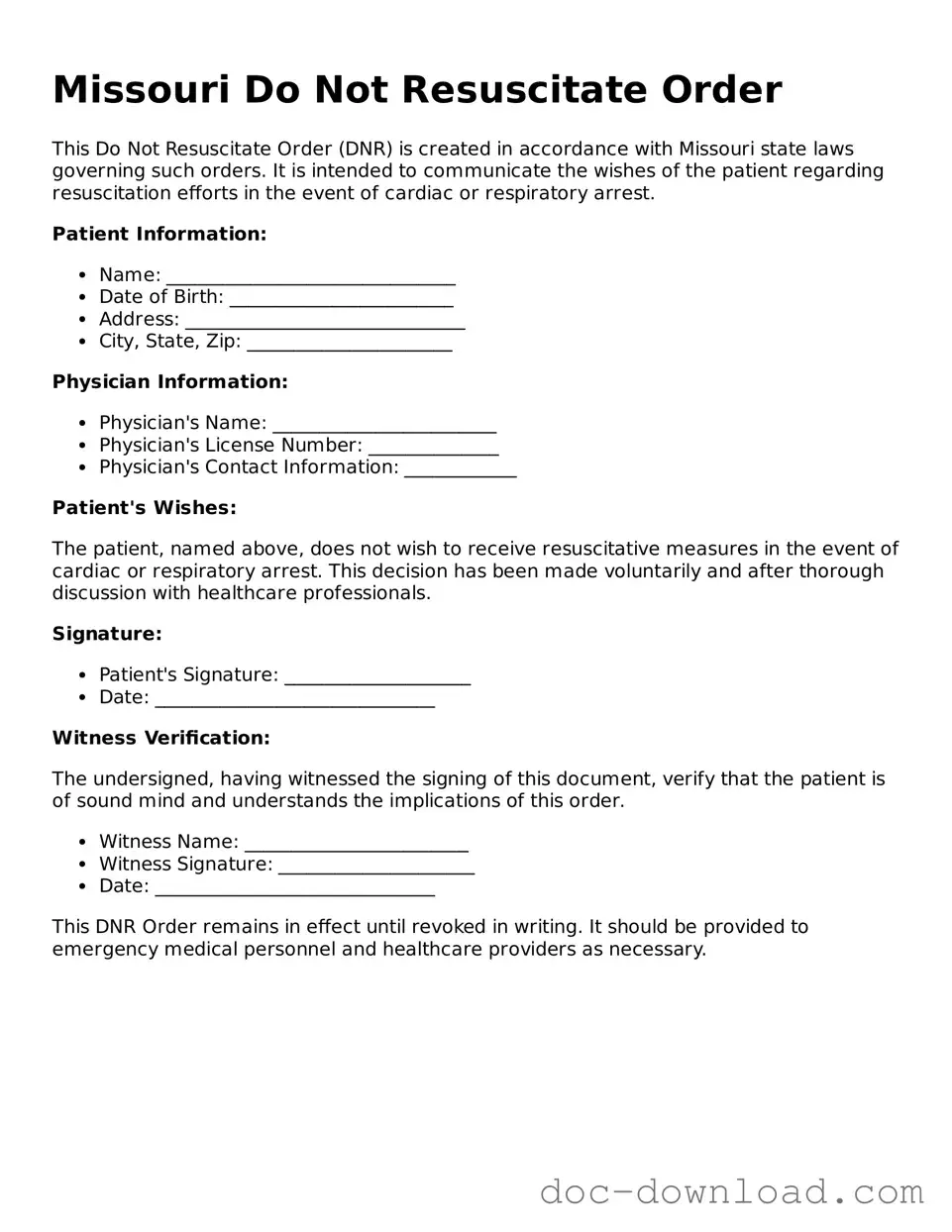The Missouri Do Not Resuscitate (DNR) Order form shares similarities with the Advance Directive, a legal document that outlines a person's preferences for medical treatment in the event they become unable to communicate their wishes. Both documents serve to express an individual's desires regarding life-sustaining treatments. While the DNR specifically addresses resuscitation efforts, the Advance Directive can cover a broader range of medical interventions, including the use of feeding tubes or ventilators. This allows individuals to have a more comprehensive say in their healthcare decisions.
Another related document is the Medical Power of Attorney. This form designates a trusted person to make healthcare decisions on behalf of an individual if they become incapacitated. Like the DNR, it emphasizes the importance of personal choice in medical care. However, the Medical Power of Attorney can encompass a wide array of decisions beyond resuscitation, allowing the appointed agent to act in accordance with the individual's values and preferences in various medical situations.
The Living Will is also comparable to the DNR Order. This document explicitly states an individual's wishes regarding end-of-life care, particularly in situations where they are terminally ill or in a persistent vegetative state. Both the Living Will and the DNR aim to ensure that a person's healthcare aligns with their beliefs and desires. While the DNR focuses on resuscitation efforts, the Living Will can address other critical medical treatments, offering a more extensive view of a person's end-of-life preferences.
The Physician Orders for Life-Sustaining Treatment (POLST) form bears resemblance to the DNR Order as well. POLST is a medical order that translates a patient's preferences for treatment into actionable medical orders for healthcare providers. Like the DNR, it is intended for individuals with serious illnesses or those nearing the end of life. The POLST form can include instructions about resuscitation, but it also covers other interventions such as hospitalization and antibiotics, making it a more comprehensive document for managing serious health conditions.
The Comfort Care Order is another document that aligns with the principles of the DNR. This order focuses on providing relief from pain and discomfort rather than aggressive life-sustaining treatments. While the DNR directs healthcare providers not to perform resuscitation, the Comfort Care Order ensures that patients receive compassionate care aimed at improving their quality of life. Both documents emphasize the importance of prioritizing patient comfort and dignity in medical decision-making.
When considering educational choices for children, parents may also find it beneficial to learn about the homeschool regulations in their state, such as the requirement for a Colorado PDF Forms for a homeschool letter of intent, which can ensure that they are following the appropriate guidelines while embarking on this rewarding journey of homeschooling.
The Do Not Intubate (DNI) Order is closely related to the DNR Order, as it specifically addresses the use of intubation to assist with breathing. While a DNR prevents resuscitation efforts, a DNI indicates that a patient does not wish to be placed on a ventilator. Both documents reflect a person's preferences regarding life-sustaining measures and highlight the importance of respecting individual choices in healthcare settings.
The Health Care Proxy is another important document that relates to the DNR Order. This form allows individuals to appoint someone to make healthcare decisions on their behalf if they are unable to do so. While the DNR specifies preferences regarding resuscitation, the Health Care Proxy empowers a designated person to make decisions that align with the individual's values and wishes. This connection emphasizes the need for clear communication and understanding among family members and healthcare providers.
The End-of-Life Care Plan also shares similarities with the DNR Order. This comprehensive plan outlines a patient's preferences for care as they approach the end of life, including their wishes regarding resuscitation and other medical interventions. Both documents aim to honor the individual's desires, ensuring that their treatment aligns with their values during a critical time. The End-of-Life Care Plan may encompass a wider range of considerations, including emotional and spiritual support, while the DNR focuses specifically on resuscitation efforts.
Lastly, the Hospice Care Plan is akin to the DNR Order in that both documents prioritize comfort and quality of life for individuals with terminal conditions. The Hospice Care Plan is designed to provide comprehensive support, including pain management and emotional care, while the DNR specifically addresses resuscitation preferences. Both documents emphasize the significance of patient-centered care, ensuring that individuals receive the support they need during their final stages of life.
